I still remember the first time I was at Yellow Submarine and happened upon the original Wares Blade box set, its cover instantly piquing my curiosity. I later found it again at Mandarake and picked it up. With LionWing Publishing’s English translation in the works, I thought it’d be fun to take a look at the original box.
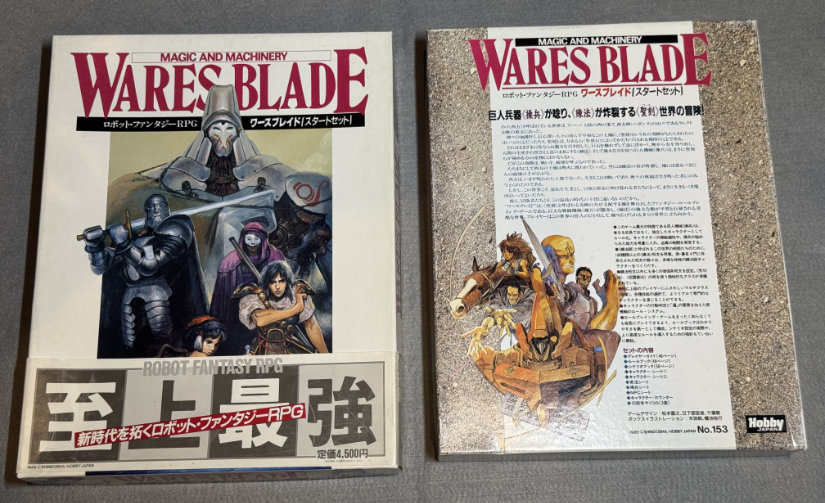
But first, just what is Wares Blade? In its own words, Wares Blade is a “magic and machinery”, a fantasy world with mecha. And while we’ll be looking at the TRPG today, it’s a world unto itself. There is a plethora of novels, and an active movement to make them available again. Back at the 2019 Tokyo Game Market I stopped by the Wares Project booth and heard a bit about their plans, including a board game “Legion”. Six years later, with out of print books being made available as PDFs and now an English translation, Wares Blade is very much alive!
Set on the continent of Ahan (アハーン大陸) with three cultural areas, the core set focuses on the Western area. Later supplements, of which there are many, look at other areas.
To be clear, the Kickstarter is for the revised edition that came out in 1994, while we’ll be taking a peek at the original 1989 version. I’ve only skimmed the sample English rules, but have referenced it a few times for consistency with speciality terms (eg 練法師 as Word-Caster). With that said, on to the box!
The Box
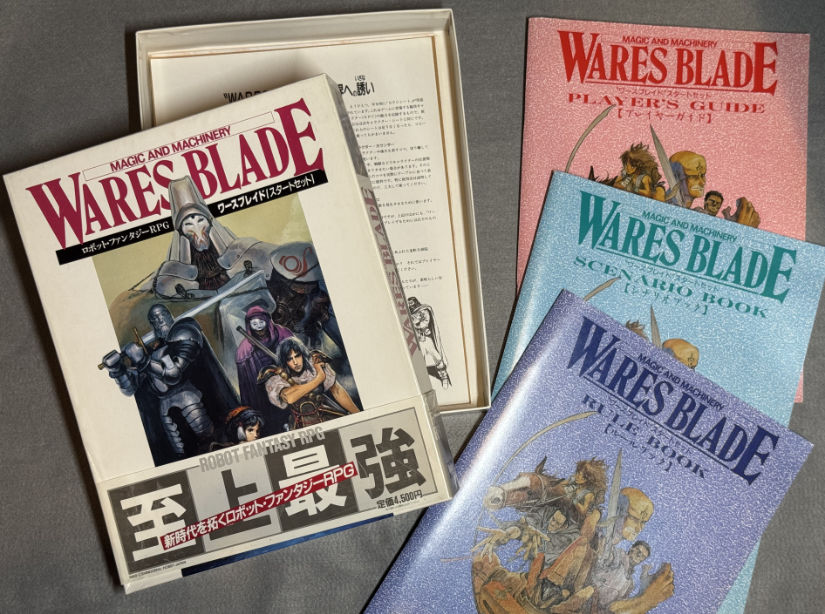
I picked up my copy for cheap due to it missing dice and being slightly damaged, but it is otherwise complete. The complete box contains a one page “Welcome to the World of Wares Blade”, 48 page Player’s Guide, 56 page Scenario Book, and 48 page Rule Book, Record Sheets, Character Counters, and three ten sided dice.
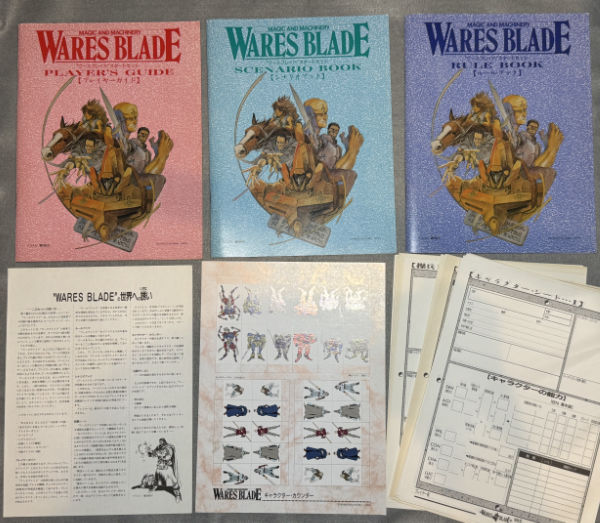
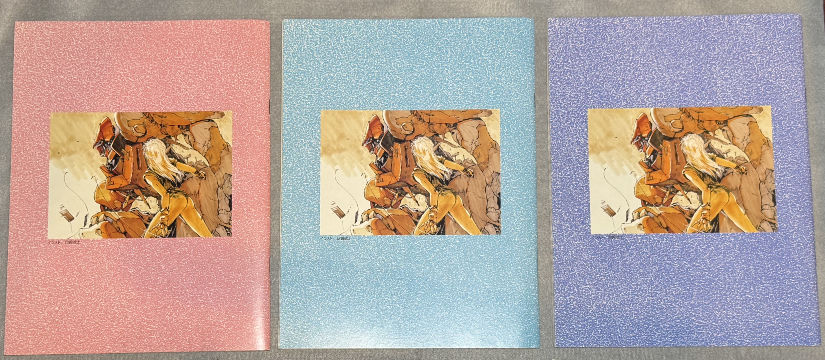
Player’s Guide
The book begins with a nice explanation and example of play. I liked how the example was structured– it included details on how to handle both success and failure of a SEN (Sense) roll.
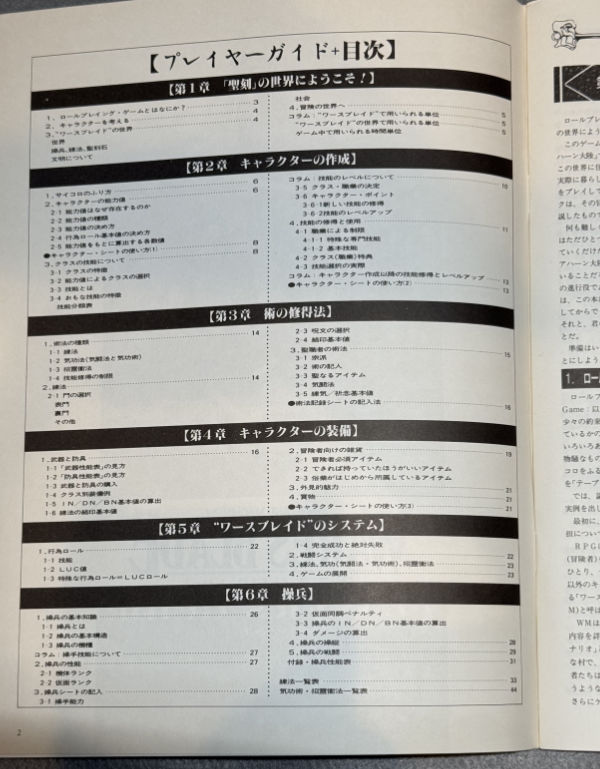
The first five pages are an introduction to the World of Sacred Marks (聖刻); followed by seven pages of character creation; three pages about skills; five pages about equipment; two pages about the system, and eighteen pages on Ryudes (the mechs).
All of the booklets follow a common three column, black and white, format. There is occasional art, tables, and diagrams. Once nice touch is the headings make reference easy, with each heading and sub-heading have an identifier (eg 3-2-3 <topic>).
Creation: Attributes
Character creation begins by explaining dice rolling and what attributes are and how they work. Attributes range between 3 and 15, with the average adventurer having all 9s and average person having all 8s.
The six statistics are:
- SEN – Sense, as in the five senses.
- AGI – Agility, the ability to move quickly and precisely
- WIL – Willpower, mental fortitude
- CON – Constitution, physical fortitude
- CHA – Charisma, influencing others
- LUC – Luck, calling on good lock and fortune, and operates differently than the other attributes.
Attributes are determined in order randomly by rolling 3D5 (roll three D10 and divide each result in half). These attributes are not used as-is, and instead the roll modifier is calculated by dividing by 3, rounded down.
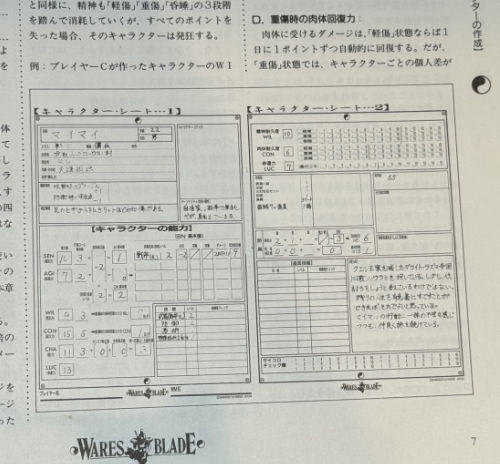
Characters have both Physical and Mental health that operate similarly, the former calculated from CON and the latter from WIL. Both have three stages, lightly wounded, heavily wounded, and coma, with the max value of each stage being the associated attribute. Luck is also not a static attribute, and is spent and gained throughout an adventure, with the max value being the initial attribute.
Creation: Classes, Skills, and Professions
There are four classes: Warrior, Word-Caster, Spiritualist, and Tradesfolk, each with their own abilities. There’s a guide to choosing the class that best matches your rolled attributes. Classes determine your base skills, amount of character points that can be spent to customize, and available professions.
Creation: Magic
This section is limited to certain classes, and deals with magic items, such as the masks used by Word-Casters, as well as spell domain and spell selection. Word-Casters choose one of eight gates (think school of magic), which are divided into two categories that stand in opposition: Luminous and Umbral Gates. Spiritualists have religious sects and holy items as well.
Creation: Items
This section details items and their effects on characters. It also introduces IN (Initiative), DN (Defense), and BN (Battle) attributes. Armor modifies both IN and BN, as well as provides soak. Weapons have BN modifiers for Melee, Charge, and Ranged attacks, as well as a chance for critical hits. These detailed tables brought back memories of the AD&D weapons charts.
Comparing the original book with the English samples of the renewal version, there’s an improvement in quick reference. The original tended to describe calculations within the text, while the new rules have callouts in clearly defined blocks.
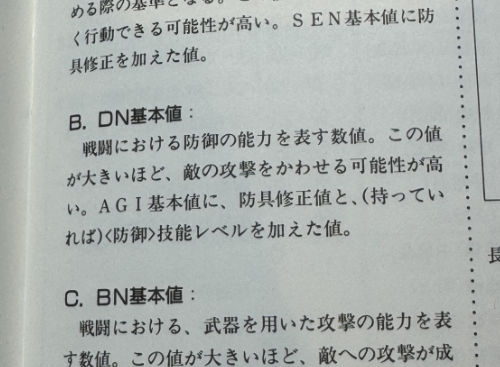
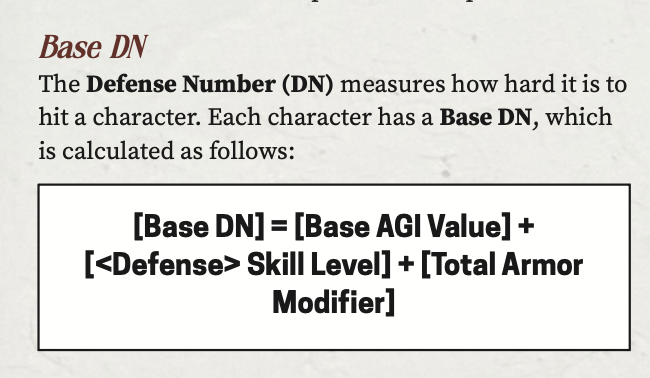
System
This chapter gives an overview of how the system works. Action rolls use a D10 and adds the appropriate attribute to the result. If a skill is applicable, its value is also added. Further still, Luck can be used to increase the number of dice rolled, one extra D10 per point of Luck spent. Two pages of rules, and example character sheets, are followed by two pages of example play, including combat.
Ryude
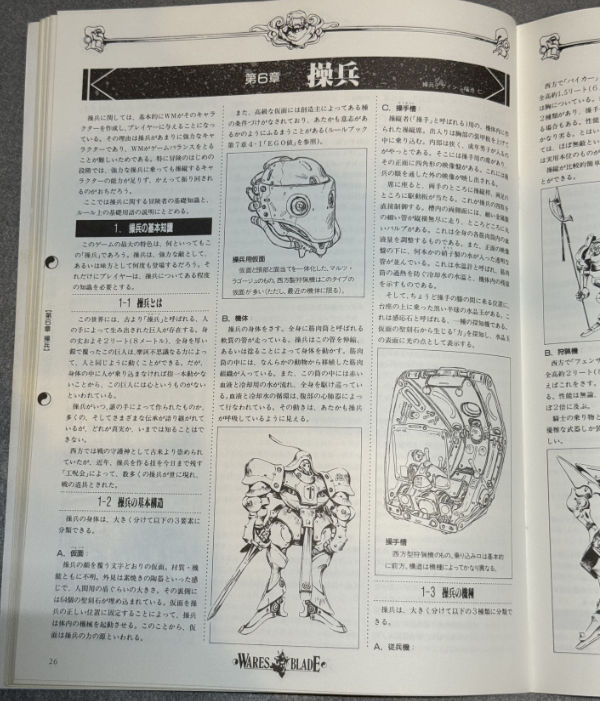 The seven pages of this chapter are all about Ryudes, the mechs that put the “Machinery” into “Magic & Machinery”. They are exceptionally powerful and rare, so the chapter focuses more on general knowledge and rules rather than concrete examples. In fact, Sanyutei Rakuten’s TRPG Rakugo 積みゲー幽霊 (Ghost of Unplayed Games) references Wares Blade and it not having concrete rules for actually acquiring a Ryude (it’s left to GM fiat). The character in the Rakugo story mentions playing in middle school and trying to find ways to steal a Ryude.
The seven pages of this chapter are all about Ryudes, the mechs that put the “Machinery” into “Magic & Machinery”. They are exceptionally powerful and rare, so the chapter focuses more on general knowledge and rules rather than concrete examples. In fact, Sanyutei Rakuten’s TRPG Rakugo 積みゲー幽霊 (Ghost of Unplayed Games) references Wares Blade and it not having concrete rules for actually acquiring a Ryude (it’s left to GM fiat). The character in the Rakugo story mentions playing in middle school and trying to find ways to steal a Ryude.
As a fan of mechs, this is a fun chapter with lots of illustrations, including that of a cockpit. Design is credited to Hitoshi Fukuchi (福地仁), a prolific mechanical designer.
Spells
The rest of the Player’s Guide consists of spells, divided by type and level. Spells have a casting time, conditions (such as above aground), effect, effect range, duration, and dodge. Ranges are in the “liet” unit, which is 4 meters.
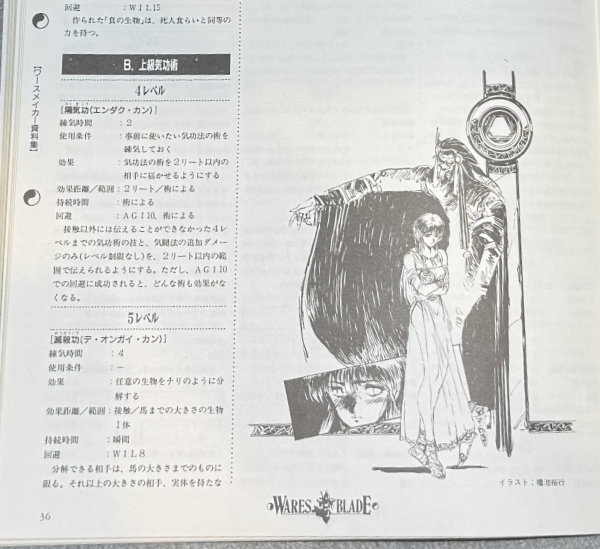
Scenario Book
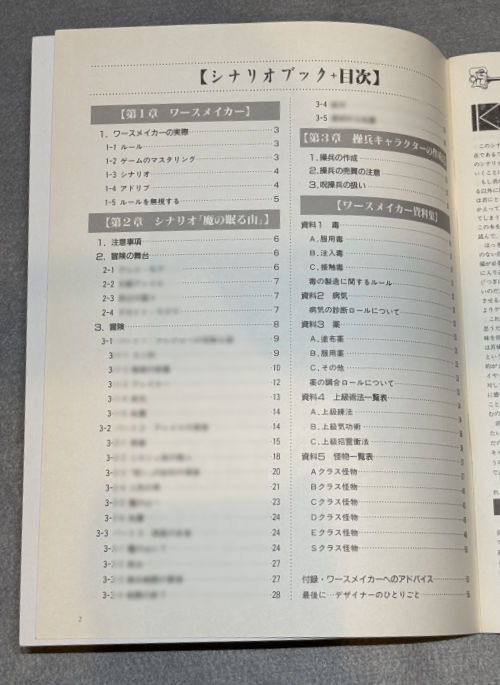
The Scenario Book contains five pages of WM (Wares Maker) advice, a three part scenario “Mountain Where the Devil Slumbers”, Rules for making Ryude, and various supplementary info such as poisons, illness, medicine, and monsters. The adventure was unlocked as a Kickstarter stretch goal, I’m skipping the rest of this book to avoid spoilers.
That being said, what type of Wares Maker (WM) advice does the book have? It covers the basics of facilitating a game, as well as how to learn the rules, giving an ordered list of rules by importance, with advice for each item:
- Action Rolls (Combat Rules)
- Magic Rules
- Ryude Combat Rules
- Character Creation
- Ryude Creation.
Advice for making scenarios is giving, as is advice on ad libbing and ignoring the rules when appropriate. All in all, I appreciate its approachability.
Rule Book
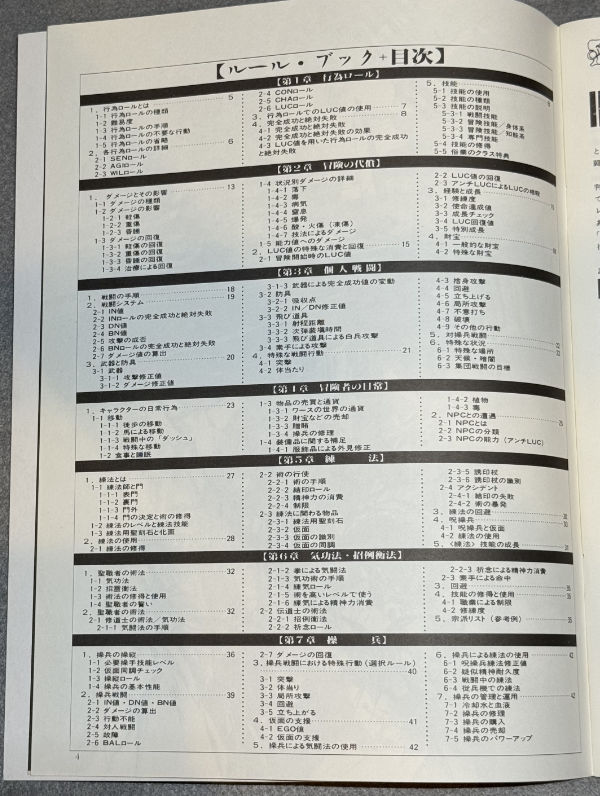 The forty-two page rulebook contains detailed rules for everything that was glossed over in the Player’s Guide, and then some. We’re going to skim this booklet, but the sections are:
The forty-two page rulebook contains detailed rules for everything that was glossed over in the Player’s Guide, and then some. We’re going to skim this booklet, but the sections are:- Action Rolls (12 pages)
- Adventurer Compensation (5 pages) that funny enough contains the effects of damage.
- Personal Combat (4 pages)
- Adventurer’s Daily Life (7 pages) essentially downtime activities for between adventurers. This includes info such as currency, food and sleep, plants, travel by horse, and such, as well as info about NPCs.
- Word-Casting (4 pages)
- Numetic Force and Invocation (4 pages) for the Spiritualists
- Ryudes (7 pages)
One thing that struck me about this booklet is it’s not just about game mechanics. Instead, it weaves world into the mechanics, showing how the characters fit into the world mechanically. While not unique to Wares Blade, there’s a feeling of characters being part of the world they adventure in. Having originated as a novel, it feels like a lot of care is given to the world of Wares Blade itself.
Extras
In addition to the booklets, character sheets and tokens are included. The token sheet is printed cardstock with two duplicate sets of five human characters and six ryudes. There are dotted lines for where to cut and then glue so that they stand up.
The four sheets are Player Sheet 1 and 2, Magic Sheet, and Ryude sheet. A nice touch is each sheet guides you through the formulas on the sheet itself. For example, next to AGI (Agility) is a box for the attribute and the base modifier, which is then added to the armor modifier, then carries over to a weapons / skills list that uses BN (Battle Number).
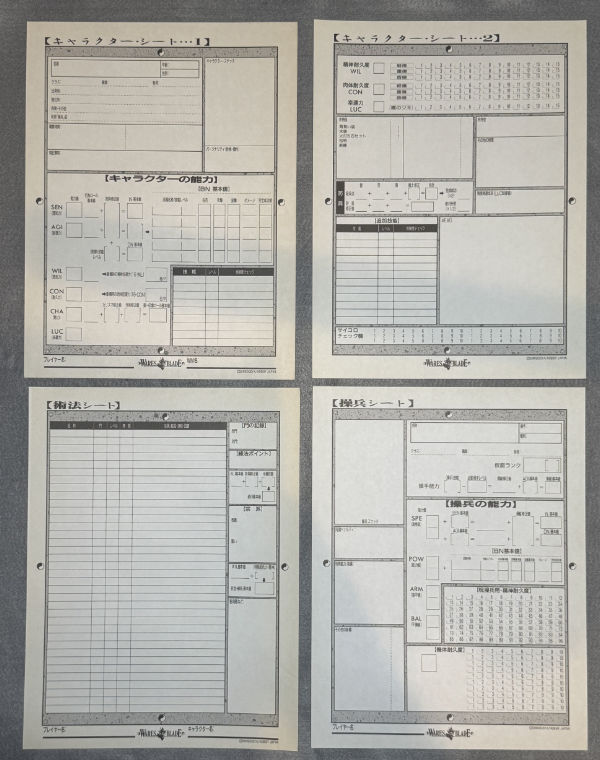
Would you like to know more?
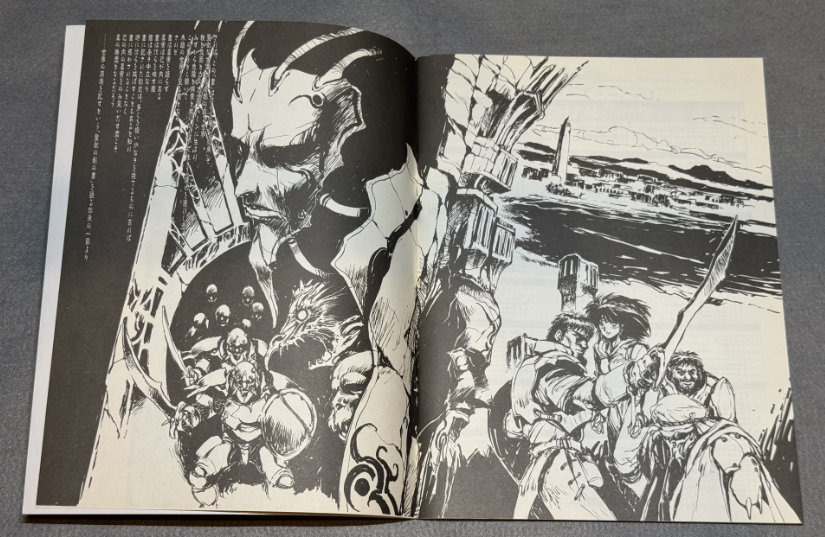
This wraps up the original 1989 Wares Blade box’s content, but there’s still a lot more to it. The original rules and some of its supplements are available in Japanese to purchase as PDFs, but Lion Wing Publishing is also bringing the game to English! The Kickstarter has ended, but late pledges are still available. There is also a sample rules PDF available from the campaign page that goes into a lot more detail about the world and rules than this blog post.
The Kickstarter campaign page and updates are also home to lots of information, and there is an actual play on Youtube:

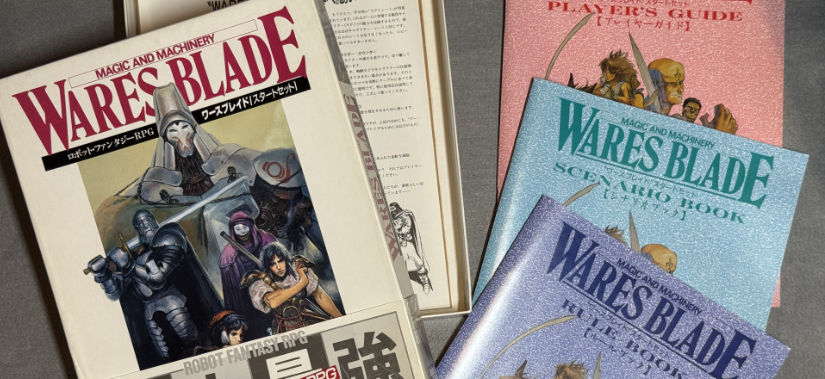
The Art in this is beautiful! Specially the cover.